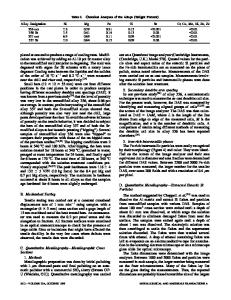Effect of the electropulsing on mechanical properties and microstructure of an ECAPed AZ31 Mg alloy
- PDF / 1,423,409 Bytes
- 8 Pages / 585 x 783 pts Page_size
- 105 Downloads / 372 Views
S.C. Liu New Technology Research & Development Center, Shenyang Research Institute of Foundry, Shenyang 110022, People’s Republic of China
B.Q. Wang and J.D. Guoa) Shenyang National Laboratory for Materials Science, Institute of Metal Research, Chinese Academy of Sciences, Shenyang 110016, People’s Republic of China (Received 23 September 2007; accepted 20 December 2007)
The mechanical properties and corresponding microstructure development of the AZ31 Mg alloy after treatment with equal channel angular pressing (ECAP) and subsequent electropulsing (ECP) was investigated. Comparing the ECAP+ECP-treated AZ31 alloy with the ECAP-treated alloy, the elongation to failure was improved significantly, while the yield stress and the ultimate tensile strength were not decreased, the grain sizes were slightly increased and more homogeneous, and the texture was barely changed. The main mechanism for the evolution of the structures and properties might be ascribed to the increased nucleation rate on recrystallization and the decreased dislocation density during the ECP treatment. It was reasonable to expect that the ECAP+ECP treatment would provide a promising approach for enhancing the mechanical properties of the Mg alloys.
I. INTRODUCTION
It is well known that Mg alloys are used mainly in the airplane, automobile, and electronics industries due to their superior specific mechanical properties.1 However, Mg alloys exhibit relatively low strength and limited ductility at ambient temperatures due to the hexagonal closed-packed crystal structure. Therefore, numerous studies have focused on the enhancement of the strength and ductility of Mg alloys. In recent years, because the equal channel angular extrusion or equal channel angular extrusion pressing (ECAP) method provides an effective technique for grain refinement and texture modification, considerable interest has been developed in improving the mechanical properties of the conventional Mg alloys by using this method.2–7 Evidently, either the strength or the ductility was increased after ECAP processing under different treatment parameters.2–5 Generally, the strength or ductility can be improved with the decreased temperature and the increase in the number of treatment passes due to the texture variation and the grain refinement.3,7,8 a)
Address all correspondence to this author. e-mail: [email protected] DOI: 10.1557/JMR.2008.0204 1570 J. Mater. Res., Vol. 23, No. 6, Jun 2008 http://journals.cambridge.org Downloaded: 16 Mar 2015
However, cracking occurred more easily at low temperature8 and was also generated more easily with the increase in the number of passes, owing to the increment of the strain density in proportion to the number of passes.9 Subsequent annealing was considered to improve the mechanical properties of the ECAP-treated Mg alloys. After treatment by traditional annealing, the elongation-tofailure of the ECAP-treated Mg alloys was almost the same or increased greatly; however, the strength decreased under the different conditions,5,6,8 which may be attri
Data Loading...











